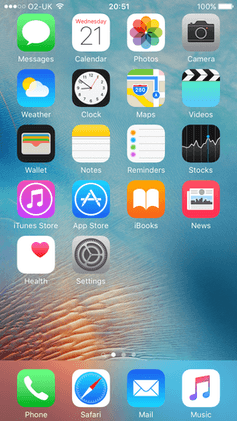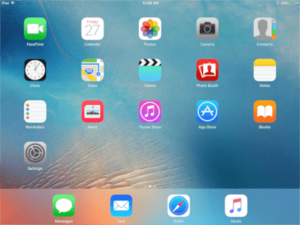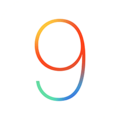IOS 9 facts for kids
| Version of the iOS operating system | |
 |
|

iOS 9 home screen on an iPhone 6s
|
|
| Developer | Apple Inc. |
|---|---|
| Source model | Closed, with open source components |
| Initial release | September 16, 2015 |
| Latest release | 9.3.6 (13G37) / July 22, 2019 |
| Repository |
|
| Update method | Software Update |
| Package manager | App Store |
| Platforms | iPhone, iPod Touch, iPad |
| Kernel type | Hybrid (XNU) |
| License | Proprietary EULA except for open-source components |
| Preceded by | iOS 8 |
| Succeeded by | iOS 10 |
| Tagline | The most advanced mobile experience. Now even more so. |
| Support status | |
| Obsolete, unsupported | |
iOS 9 was a big update for Apple's iOS mobile operating system. It was the ninth main version, coming after iOS 8. Apple Inc. announced it on June 8, 2015, and released it to everyone on September 16, 2015. Later, iOS 10 took its place on September 13, 2016.
iOS 9 brought many cool new features to apps already on your device. For example, the Notes app let you draw, add pictures, and make fancy lists. A brand-new Apple News app gathered articles from different places. Apple Maps started showing public transportation routes, though only in a few cities at first.
A major new feature was "proactivity." This meant Siri and search worked together to understand what you needed. They could give you information like weather or sports scores before you even asked. For iPads, iOS 9 added new ways to use more than one app at a time. In a later update, iOS 9.3, Apple added Night Shift mode. This mode made your screen colors warmer at night, which could help your eyes and sleep. iOS 9 also introduced Quick Actions and Peek and Pop for iPhones with 3D Touch. These features let you do things faster by pressing harder on the screen.
People generally liked iOS 9. They thought the new Siri and search features were very helpful. The multitasking for iPad and the improved Notes app also got good reviews. However, some thought the Apple News app didn't have enough good articles. Apple Maps was also criticized for its limited public transit information.
Just five days after it came out, Apple said that over half of all active iOS devices had iOS 9. This was the fastest adoption rate for a new operating system at that time. iOS 9 was the last version to use the classic "slide-to-unlock" feature. It was also the last iOS version to work on older devices like the iPhone 4s and iPad 2.
Contents
What's New in iOS 9
Apple first showed iOS 9 at its Worldwide Developers Conference on June 8, 2015. Developers could try out the first test version right away. For the first time, the public could also test new iOS versions before they were officially released. This public test program started because of problems with Apple Maps when it first launched. iOS 9 was officially released to everyone on September 16, 2015.
Cool System Features
3D Touch: New Ways to Interact
For the iPhone 6s and iPhone 6s Plus, iOS 9 added a special screen feature called 3D Touch. It's like a "force touch" that some Apple laptops have. You could press harder on an app icon to see "Quick Actions" or shortcuts. It also had "Peek and Pop." This let you press lightly to "Peek" at content in a small window. If you pressed harder, you would "Pop" into the full content. The phone would even give you a little vibration when you pressed harder.
Battery Life Improvements
iOS 9 helped save battery in two ways. If your phone was face-down, the screen wouldn't light up for notifications. This saved power. Apple also added a "Low Power Mode." When your battery got to 20%, your phone would ask if you wanted to turn it on. This mode would pause things like background app updates and email syncing. The battery icon would turn yellow. When your battery charged past 80%, Low Power Mode would turn off automatically.
Fresh New Look
iOS 9 changed the system font to "San Francisco." This replaced the older "Helvetica Neue" font. A new battery widget appeared in the Notification Center. It showed the battery life of your phone and any connected Bluetooth devices. The keyboard also got a small change: when the shift key was off, it showed lowercase letters instead of all capital letters.
Easier Installation
Updating to iOS 9 needed less space than iOS 8. It only needed 1.3 GB, compared to 4.58 GB for iOS 8. If you didn't have enough space, iOS 9 could temporarily delete some apps to make room. After the update, it would put them back from the App Store. iOS 9 also had "app thinning." This meant your device only downloaded the parts of an app it needed, saving even more space.
Multitasking for iPad
For the first time, iOS 9 added many features to the iPad to help you do more at once.
- Slide Over: You could swipe from the right edge of the screen to bring in a second app. This app would take up about one-third of the screen. You could quickly do something in it, then slide it away.
- Split Screen: If you pulled the Slide Over app further, you could enter Split Screen. This let you use two apps side-by-side at the same time, splitting the screen evenly.
- Picture in Picture: This mode let you shrink FaceTime calls or videos into a small window. You could keep watching them while doing other things on your iPad.
Not all iPads had all these features. Split Screen worked on iPad Air 2, iPad mini 4, and iPad Pro. Slide Over and Picture in Picture worked on iPad Air, iPad Air 2, iPad mini 2 and newer, and the iPad Pro.
On iPhones, if you tapped a notification that opened another app, a "back" button appeared at the top left. This let you easily go back to the app you were using before. The app switcher also changed on iPhone, showing apps in a card-like view instead of side-by-side.
Night Shift Mode
Night Shift was a new display mode added in iOS 9.3. It made your screen colors warmer, especially at night. This was similar to a computer program called F.lux. Night Shift could turn on and off automatically based on the time and your location. You could also set your own schedule or adjust how warm the colors looked. There was a quick button for it in the Control Center. Night Shift only worked on devices with a 64-bit processor, like those with the Apple A7 chip or newer.
Faster Performance
iOS 9 made things run smoother and faster by using something called the Metal API more often. Metal was first introduced in iOS 8 for games. In iOS 9, Apple used Metal for many parts of the user interface and graphics, making everything feel quicker.
Smart "Proactivity"
A big part of iOS 9 was its "intelligence." This combined Siri and Search (which used to be called Spotlight). iOS became smarter about things like time and location. It could try to guess what you needed and give you information ahead of time. When you searched, it could show instant answers like weather, sports scores, or news. You could find this search screen by swiping down on the notifications, using the search bar in Safari, or swiping left on the home screen.
This intelligence also worked inside apps. For example, in Mail, if an email had event details, it could suggest adding them to your Calendar. Siri also knew what was on your screen when you held the home button, so it could help you with what you were looking at.
Better Security
iOS 9 added important security upgrades. The default passcode became 6 digits instead of 4. This made it much harder for someone to guess your passcode. It also added support for two-factor authentication, which is an extra layer of security for your accounts.
Settings App Search
The Settings app in iOS 9 got a new search bar. This made it much easier to find specific settings and options quickly. You could also choose to group notifications by the app they came from.
Other Handy Changes
On the iPad, you could drag two fingers on the keyboard to move the cursor around like a mouse. This made selecting text much easier. This feature also came to iPhone 6S and 6S Plus by pressing harder on the keyboard. iPads also got a shortcut bar for cut, copy, paste, undo, and redo. Folders on iPad could now show 16 apps per page, letting you store more apps in one folder.
iOS 9 also introduced Wi-Fi Assist. This feature, turned on by default, would automatically switch your phone to cellular data if your Wi-Fi signal was weak. If you saw flight information, you could tap a link to see a preview of that flight.
App Features
iBooks
With iOS 9.3 and later, you could save PDFs from Safari or iTunes to the iBooks app. These PDFs would then sync with iCloud.
iCloud Drive App
iOS 9 added a setting to put an iCloud Drive app on your home screen. This app let you save and look at your files and folders stored in iCloud.
Health App Updates
The Health app, which first appeared in iOS 8, could now be used in landscape mode on iPhone. It also added support for tracking more types of health data, like reproductive health, UV exposure, water intake, and how much time you spent sitting. In iOS 9.3, it also started tracking sleep, exercise, and weight from the Apple Watch.
Messages App
The Messages app now let you search for specific text within your conversations. When it found the text, it would highlight it for you.
Maps App
Apple Maps added public transit directions in many major cities around the world. It also got a "Nearby" feature. This feature recommended shops, restaurants, and places to go that were close to you. You could even specify what kind of food you wanted.
News App
iOS 9 included a new Apple News app. This app replaced the old Newsstand app. It gathered news articles from different sources and presented them in a clean, easy-to-read format. The News app also supported RSS feeds from the Safari web browser. At first, it was only in the United States, but it later came to the United Kingdom and Australia.
Notes App
The Notes app got many improvements in iOS 9. You could now draw sketches with different tools, including a ruler. You could also add pictures. Links to websites and map locations looked much nicer and more visual. The app also supported iCloud and made it easy to create folders for your notes. In iOS 9.3, you could even protect your notes with a passcode or Touch ID.
Photos App
The Photos app in iOS 9 had an improved scrubber bar for viewing photos. It also automatically created "Screenshots" and "Selfies" albums. You could easily select multiple photos by holding and dragging. A new "Hide" option let you hide sensitive pictures. You could also pinch to zoom while watching a video.
Safari Web Browser
With iOS 9, the Safari web browser allowed third-party apps to block content, like ads. Safari also let you change how Reader mode looked, with options for different fonts and background colors.
Watch App
The Apple Watch app was simply renamed to "Watch."
Wallet App
The Passbook app was renamed Wallet in iOS 9. It added support for store loyalty cards, gift cards, and Apple Pay in the UK. You could also quickly open the Wallet app from the lock screen.
Common Problems with iOS 9
"Error 53" Issue
In early 2016, some people found that their iPhones running iOS 9 became unusable if they had been repaired by someone other than Apple, especially if the Touch ID sensor was involved. This was called "Error 53." Apple explained that this was a security feature. It made sure that the Touch ID sensor was the original one paired with the phone. If it wasn't, Touch ID and Apple Pay would be disabled to keep your data safe. Apple later released an update to iOS 9.2.1 that fixed this issue.
Date Reboot Bug
Another bug was found in February 2016. If you set the date on a 64-bit device to January 1, 1970, the device would get stuck in a loop of restarting. iOS 9.3, released in March 2016, fixed this problem.
iPad Pro Bricking Issue
In May 2016, an update to iOS 9.3.2 caused some 9.7-inch iPad Pros to stop working. They would show a "Connect to iTunes" message and an "Error 56" in iTunes. Apple temporarily stopped offering the update for those iPads. A new version of iOS 9.3.2 was released in June 2016 that fixed the problem.
Spyware Attack
In August 2016, iOS 9.3.5 was released to fix three serious security flaws. These flaws could allow a type of spyware called "Pegasus" to be installed on a device without the user knowing. This spyware could read text messages, emails, track calls, find the phone's location, and even turn on the microphone. It could also gather information from many popular apps. This was a big deal because it was one of the first times a remote "jailbreak" (taking full control of the phone) exploit was found on an iPhone. Apple quickly fixed it.
"Broadpwn" Wi-Fi Problem
In July 2017, a major Wi-Fi security problem called "Broadpwn" was found. It affected many iOS and Android devices. This problem could let an attacker take control of nearby devices through Wi-Fi. Apple fixed this in iOS 10.3.3. However, older devices running iOS 9, like the iPad 2 and iPhone 4s, did not get this update. This raised concerns about their safety, especially in schools.
iPhone 4s Lawsuit
In December 2015, Apple faced a lawsuit because some people felt that the iOS 9 update made their iPhone 4s devices very slow or even unusable. The iPhone 4s had less memory (RAM) than newer phones, so it struggled with iOS 9. In 2022, a settlement was reached. People who downloaded iOS 9 onto an iPhone 4s in New York or New Jersey could receive $15 each from a fund Apple paid.
Activation Error
Around early 2018, some users with devices running iOS 9 that had the A9 chip started seeing an "Activation Error" screen. This screen would appear randomly, and users couldn't get past it without restoring their device in iTunes. Restoring the device would erase all data. This problem still happens for some users today, and Apple has not publicly commented on it.
Devices That Could Use iOS 9
All devices that supported iOS 8 could also use iOS 9.
iPhone |
iPod Touch
|
iPad
|
Images for kids
See also
 In Spanish: IOS 9 para niños
In Spanish: IOS 9 para niños




